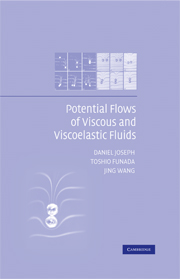Book contents
- Frontmatter
- Contents
- Preface
- List of Abbreviations
- 1 Introduction
- 2 Historical notes
- 3 Boundary conditions for viscous fluids
- 4 Helmholtz decomposition coupling rotational to irrotational flow
- 5 Harmonic functions that give rise to vorticity
- 6 Radial motions of a spherical gas bubble in a viscous liquid
- 7 Rise velocity of a spherical cap bubble
- 8 Ellipsoidal model of the rise of a Taylor bubble in a round tube
- 9 Rayleigh–Taylor instability of viscous fluids
- 10 The force on a cylinder near a wall in viscous potential flows
- 11 Kelvin–Helmholtz instability
- 12 Energy equation for irrotational theories of gas–liquid flow: viscous potential flow, viscous potential flow with pressure correction, and dissipation method
- 13 Rising bubbles
- 14 Purely irrotational theories of the effect of viscosity on the decay of waves
- 15 Irrotational Faraday waves on a viscous fluid
- 16 Stability of a liquid jet into incompressible gases and liquids
- 17 Stress-induced cavitation
- 18 Viscous effects of the irrotational flow outside boundary layers on rigid solids
- 19 Irrotational flows that satisfy the compressible Navier–Stokes equations
- 20 Irrotational flows of viscoelastic fluids
- 21 Purely irrotational theories of stability of viscoelastic fluids
- 22 Numerical methods for irrotational flows of viscous fluid
- Appendix A Equations of motion and strain rates for rotational and irrotational flow in Cartesian, cylindrical, and spherical coordinates
- Appendix B List of frequently used symbols and concepts
- References
- Index
1 - Introduction
Published online by Cambridge University Press: 09 October 2009
- Frontmatter
- Contents
- Preface
- List of Abbreviations
- 1 Introduction
- 2 Historical notes
- 3 Boundary conditions for viscous fluids
- 4 Helmholtz decomposition coupling rotational to irrotational flow
- 5 Harmonic functions that give rise to vorticity
- 6 Radial motions of a spherical gas bubble in a viscous liquid
- 7 Rise velocity of a spherical cap bubble
- 8 Ellipsoidal model of the rise of a Taylor bubble in a round tube
- 9 Rayleigh–Taylor instability of viscous fluids
- 10 The force on a cylinder near a wall in viscous potential flows
- 11 Kelvin–Helmholtz instability
- 12 Energy equation for irrotational theories of gas–liquid flow: viscous potential flow, viscous potential flow with pressure correction, and dissipation method
- 13 Rising bubbles
- 14 Purely irrotational theories of the effect of viscosity on the decay of waves
- 15 Irrotational Faraday waves on a viscous fluid
- 16 Stability of a liquid jet into incompressible gases and liquids
- 17 Stress-induced cavitation
- 18 Viscous effects of the irrotational flow outside boundary layers on rigid solids
- 19 Irrotational flows that satisfy the compressible Navier–Stokes equations
- 20 Irrotational flows of viscoelastic fluids
- 21 Purely irrotational theories of stability of viscoelastic fluids
- 22 Numerical methods for irrotational flows of viscous fluid
- Appendix A Equations of motion and strain rates for rotational and irrotational flow in Cartesian, cylindrical, and spherical coordinates
- Appendix B List of frequently used symbols and concepts
- References
- Index
Summary
The theory of potential flow is a topic in both the study of fluid mechanics and in mathematics. The mathematical theory treats properties of vector fields generated by gradients of a potential. The curl of a gradient vanishes. The local rotation of a vector field is proportional to its curl so that potential flows do not rotate as they deform. Potential flows are irrotational.
The mathematical theory of potentials goes back to the 18th century (see Kellogg, 1929). This elegant theory has given rise to jewels of mathematical analysis, such as the theory of a complex variable. It is a well-formed or “mature” theory, meaning that the best research results have already been obtained. We are not going to add to the mathematical theory; our contributions are to the fluid mechanics theory, focusing on effects of viscosity and viscoelasticity. Two centuries of research have focused exclusively on the motions of inviscid fluids. Among the 131,000,000 hits that come up under “potential flows” on Google search are mathematical studies of potential functions and studies of inviscid fluids. These studies can be extended to viscous fluids at small cost and great profit.
The fluid mechanics theory of potential flow goes back to Euler in 1761 (see Truesdell, 1954, §36). The concept of viscosity was not known in Euler's time. The fluids he studied were driven by pressures, not by viscous stresses.
- Type
- Chapter
- Information
- Publisher: Cambridge University PressPrint publication year: 2007

